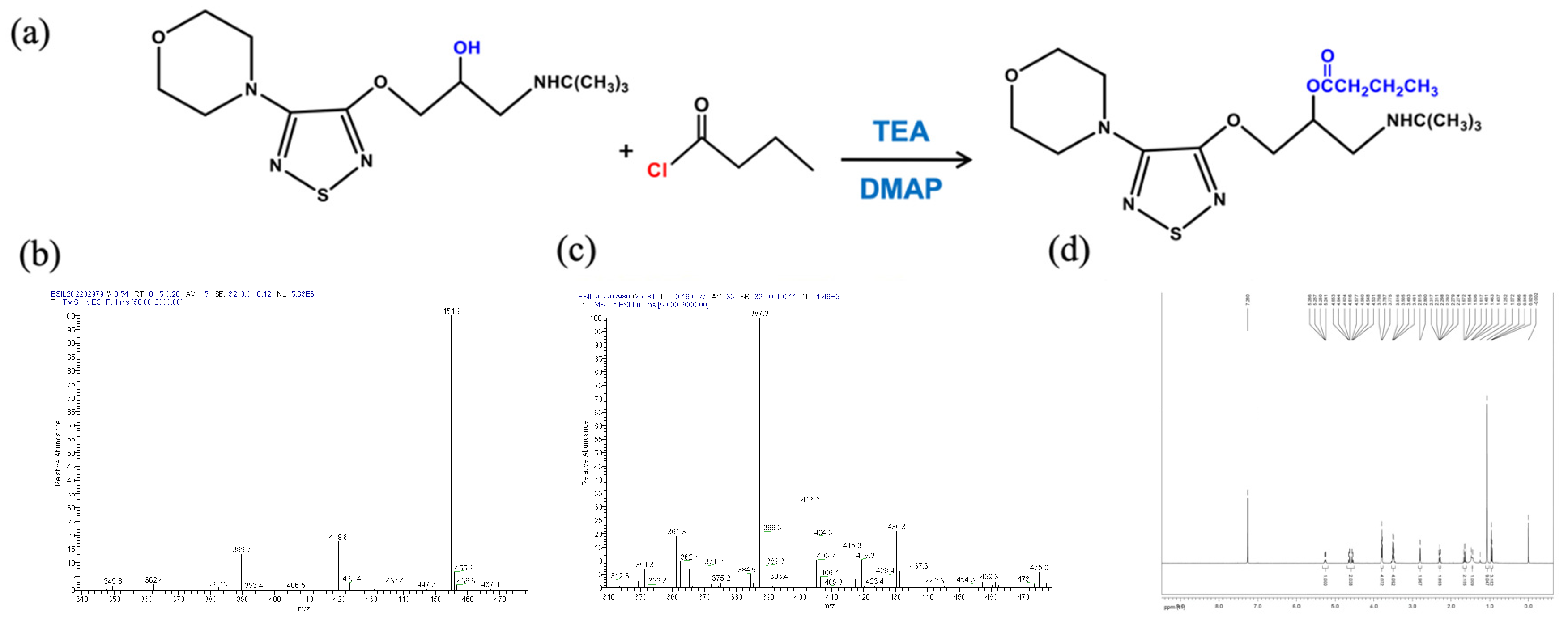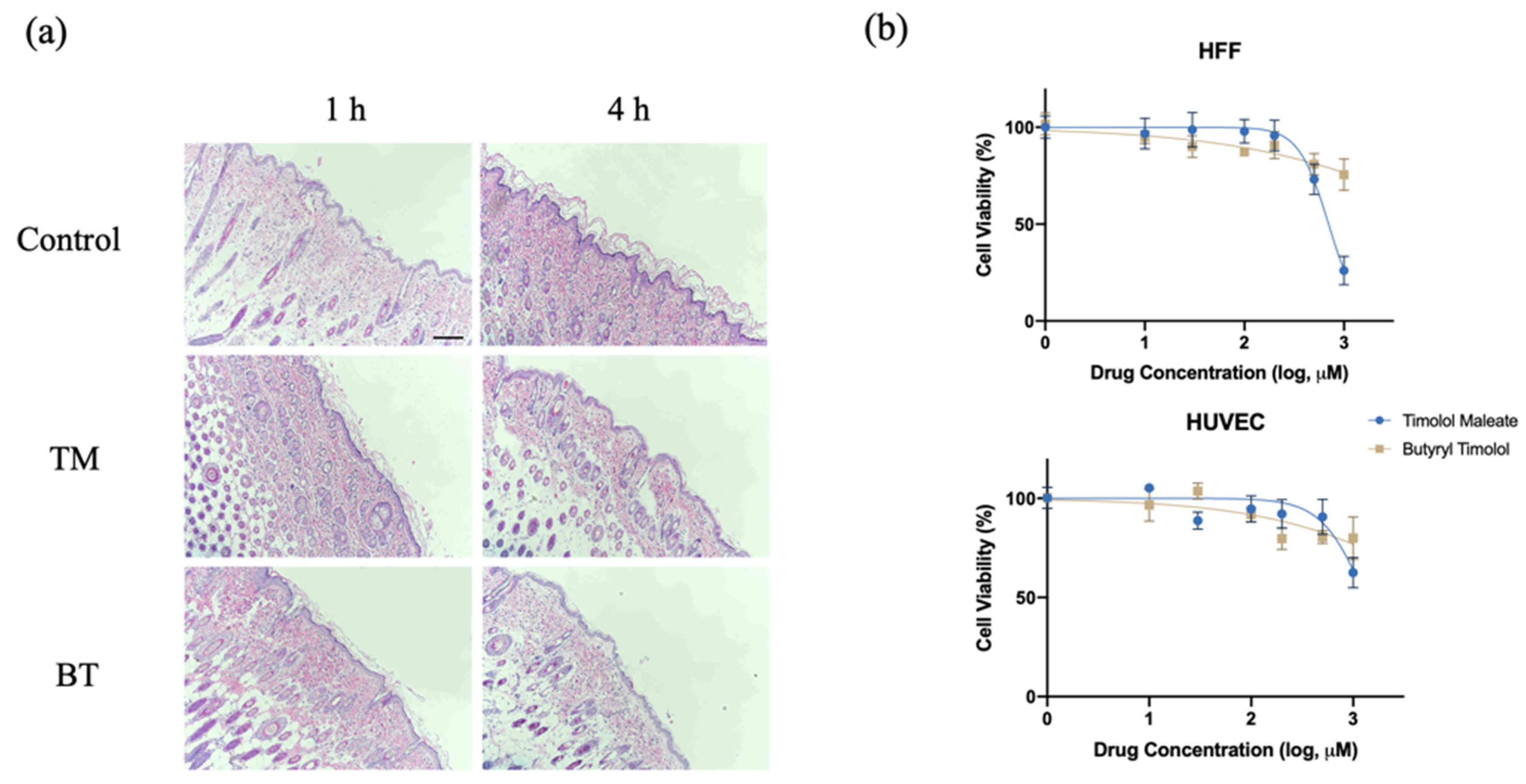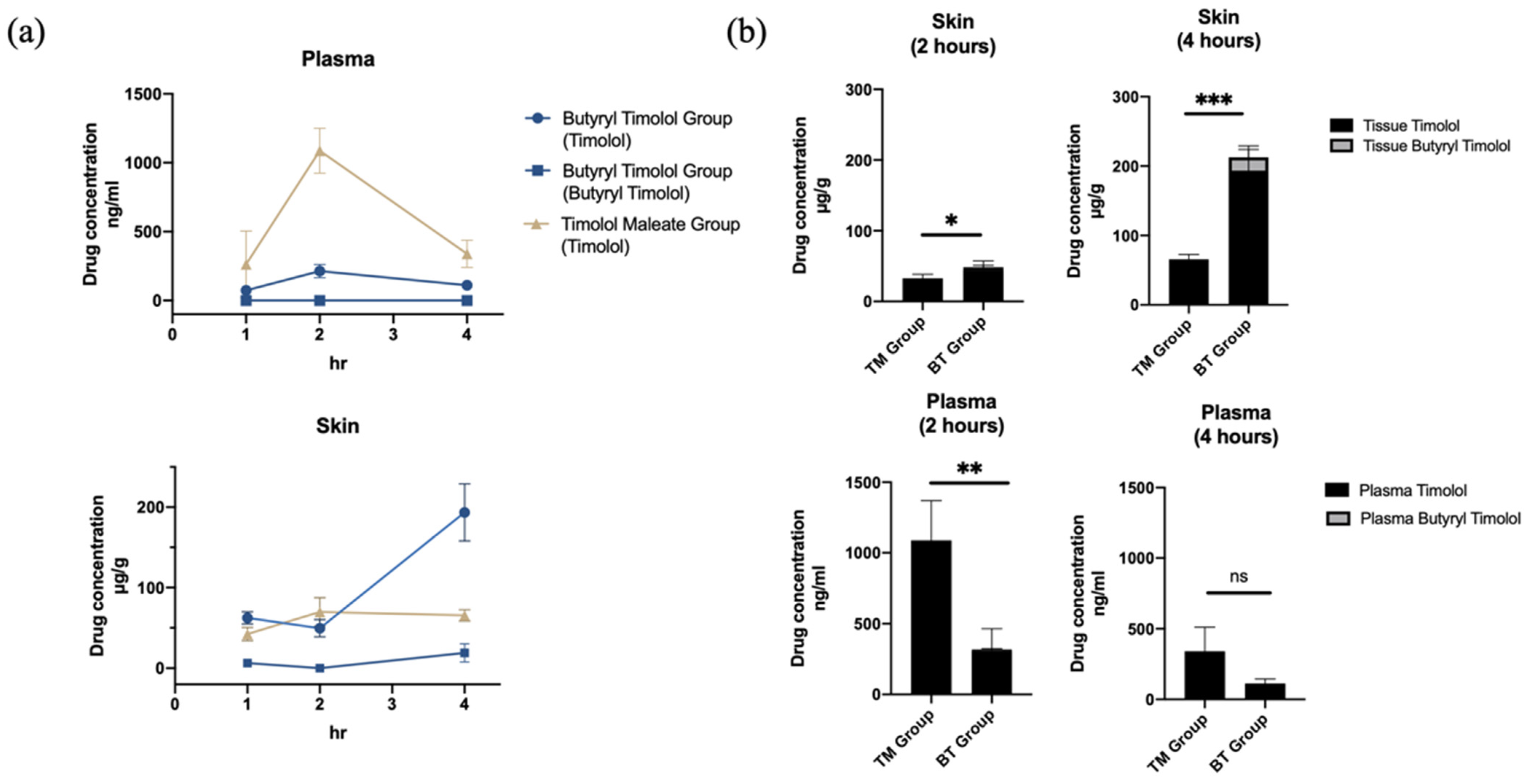Evaluation of Transdermal Transport and Concurrent Cutaneous Hydrolysis of Timolol Prodrug for the Treatment of Infantile Hemangiomas
Abstract
:1. Introduction
2. Materials and Methods
2.1. Materials
2.2. Pro-Drug BT Synthesis
2.3. Animals
2.4. Harvesting Infantile Hemangioma Cells
2.5. Cell Culture Conditions
2.6. In Vitro and In Vivo Toxicity Evaluations of BT
2.6.1. Histological Examination of Rat Dorsal Skin after Topical Application
2.6.2. Cytotoxicity of BT in IH and Normal Skin Cells
2.7. Skin Permeation and Skin Absorption Studies
2.7.1. Permeation Studies Using Franz Diffusion Cells
2.7.2. Quantification of BT and Timolol in Plasma and Skin Tissue
2.7.3. Ex Vivo Human Skin Absorption
2.8. LC-MS Analysis
2.9. Data Analysis
3. Results
3.1. Characterization and Toxicity Evaluation of Pro-Drug BT
3.2. BT Exhibits Superior Skin Permeation and High Biotransformation
3.2.1. BT Exhibits Superior Skin Permeation and Skin Retention Compared with That of TM Ex Vivo
3.2.2. BT Demonstrates High Skin Retention but Low Systemic Absorbance In Vivo
3.2.3. BT Is Converted into Timolol in a Time-Dependent Manner
3.3. BT Exhibits Similar IH Cellular Biocompatibility to TM
4. Discussion
5. Conclusions
6. Patents
Author Contributions
Funding
Institutional Review Board Statement
Informed Consent Statement
Data Availability Statement
Acknowledgments
Conflicts of Interest
References
- Dickison, P.; Christou, E.; Wargon, O. A prospective study of infantile hemangiomas with a focus on incidence and risk factors. Pediatr. Dermatol. 2011, 28, 663–669. [Google Scholar] [CrossRef] [PubMed]
- Munden, A.; Butschek, R.; Tom, W.L.; Marshall, J.S.; Poeltler, D.M.; Krohne, S.E.; Alió, A.B.; Ritter, M.; Friedlander, D.F.; Catanzarite, V.; et al. Prospective study of infantile haemangiomas: Incidence, clinical characteristics and association with placental anomalies. Br. J. Dermatol. 2014, 170, 907–913. [Google Scholar] [CrossRef]
- Haggstrom, A.N.; Baselga, E.; Chamlin, S.L.; Drolet, B.A.; Garzon, M.C.; Holland, K.E.; Horii, K.A.; Lauren, C.; Lucky, A.; Mancini, A.J.; et al. Localized infantile hemangiomas of the face and scalp: Predilection for the midline and periorbital and perioral skin. Pediatr. Dermatol. 2018, 35, 774–779. [Google Scholar] [CrossRef] [PubMed]
- Chang, S.J.; Qiao, C.; Chang, L.; Gao, W.; Jin, Y.; Ma, G.; Qiu, Y.; Lin, X. A 7-year follow-up study on untreated deep or mixed facial infantile hemangioma in East-Asian patients: When propranolol was not yet an option. J. Dermatol. 2019, 46, 962–966. [Google Scholar] [CrossRef] [PubMed]
- Baselga, E.; Roe, E.; Coulie, J.; Muñoz, F.Z.; Boon, L.M.; McCuaig, C.; Hernandez-Martín, A.; Gich, I.; Puig, L. Risk Factors for Degree and Type of Sequelae After Involution of Untreated Hemangiomas of Infancy. JAMA Dermatol. 2016, 152, 1239–1243. [Google Scholar] [CrossRef]
- Costa, V.A.; Haimowitz, R.; Cheng, Y.I.; Wang, J.; Silverman, R.A.; Bauman, N.M. Social Impact of Facial Infantile Hemangiomas in Preteen Children. JAMA Otolaryngol. Head Neck Surg. 2016, 142, 13–19. [Google Scholar] [CrossRef]
- Leaute-Labreze, C.; Dumas de la Roque, E.; Hubiche, T.; Boralevi, F.; Thambo, J.-B.; Taieb, A. Propranolol for severe hemangiomas of infancy. N. Engl. J. Med. 2008, 358, 2649–2651. [Google Scholar] [CrossRef]
- Léauté-Labrèze, C.; Hoeger, P.; Mazereeuw-Hautier, J.; Guibaud, L.; Baselga, E.; Posiunas, G.; Phillips, R.J.; Caceres, H.; Lopez Gutierrez, J.C.; Ballona, R.; et al. A randomized, controlled trial of oral propranolol in infantile hemangioma. N. Engl. J. Med. 2015, 372, 735–746. [Google Scholar] [CrossRef] [Green Version]
- Torres-Pradilla, M.; Baselga, E. Failure of intralesional propranolol in infantile hemangiomas. Pediatr. Dermatol. 2014, 31, 156–158. [Google Scholar] [CrossRef]
- Zaher, H.; Rasheed, H.; Esmat, S.; Hegazy, R.A.; Gawdat, H.I.; Hegazy, R.A.; El-Komy, M.; Abdelhalim, D.M. Propranolol and infantile hemangiomas: Different routes of administration, a randomized clinical trial. Eur. J. Dermatol. 2013, 23, 646–652. [Google Scholar] [CrossRef]
- Chan, H.; McKay, C.; Adams, S.; Wargon, O. RCT of timolol maleate gel for superficial infantile hemangiomas in 5- to 24-week-olds. Pediatrics 2013, 131, e1739–e1747. [Google Scholar] [CrossRef] [PubMed] [Green Version]
- Püttgen, K.; Lucky, A.; Adams, D.; Pope, E.; McCuaig, C.; Powell, J.; Feigenbaum, D.; Savva, Y.; Baselga, E.; Holland, K.; et al. Topical Timolol Maleate Treatment of Infantile Hemangiomas. Pediatrics 2016, 138, e20160355. [Google Scholar] [CrossRef] [PubMed] [Green Version]
- Krowchuk, D.P.; Frieden, I.J.; Mancini, A.J.; Darrow, D.H.; Blei, F.; Greene, A.K.; Annam, A.; Baker, C.N.; Frommelt, P.C.; Hodak, A.; et al. Clinical Practice Guideline for the Management of Infantile Hemangiomas. Pediatrics 2019, 143, e20183475. [Google Scholar] [CrossRef] [PubMed] [Green Version]
- Drolet, B.A.; Boakye-Agyeman, F.; Harper, B.; Stefanko, N.; Melloni, C. Systemic timolol exposure following topical application to infantile hemangiomas. J. Am. Acad. Dermatol. 2020, 82, 733–736. [Google Scholar] [CrossRef] [Green Version]
- Bundgaard, H.; Buur, A.; Chang, S.C.; Lee, V.H.L. Prodrugs of timolol for improved ocular delivery: Synthesis, hydrolysis kinetics and lipophilicity of various timolol esters. Int. J. Pharm. 1986, 33, 15–26. [Google Scholar] [CrossRef]
- Huang, L.; Bischoff, J. Isolation of Stem Cells, Endothelial Cells and Pericytes from Human Infantile Hemangioma. Bio-Protocol 2020, 10, e3487. [Google Scholar] [CrossRef]
- Sloan, K.B. Functional Group Considerations in the Development of Prodrug Approaches to Solving Topical Delivery Problems. In Prodrugs: Topical and Ocular Drug Delivery; Sloan, K.B., Ed.; Marcel Dekker, Inc.: New York, NY, USA, 1992; pp. 17–116. [Google Scholar]
- Müller, B.; Kasper, M.; Surber, C.; Imanidis, G. Permeation, metabolism and site of action concentration of nicotinic acid derivatives in human skin. Correlation with topical pharmacological effect. Eur. J. Pharm. Sci. 2003, 20, 181–195. [Google Scholar] [CrossRef]
- Bonina, F.P.; Puglia, C.; Barbuzzi, T.; Palagiano, F.; Rimoli, M.G.; Saija, A. In vitro and in vivo evaluation of polyoxyethylene esters as dermal prodrugs of ketoprofen, naproxen and diclofenac. Eur. J. Pharm. Sci. 2001, 14, 123–134. [Google Scholar] [CrossRef]
- Lipp, R.; Laurent, H.; Günther, C.; de Caprariis, P.; Palagiano, F.; Grazia Rimoli, M.; Saija, A. Prodrugs of gestodene for matrix-type transdermal drug delivery systems. Pharm. Res. 1998, 15, 1419–1424. [Google Scholar] [CrossRef]
- Borok, J.; Gangar, P.; Admani, S.; Friedlander, P.S.F. Safety and efficacy of topical timolol treatment of infantile haemangioma: A prospective trial. Br. J. Dermatol. 2018, 178, e51–e52. [Google Scholar] [CrossRef]
- Sun, Y.; Qiu, F.; Hu, C.; Guo, Y.; Lei, S. Hemangioma Endothelial Cells and Hemangioma Stem Cells in Infantile Hemangioma. Ann. Plast. Surg. 2022, 88, 244–249. [Google Scholar] [CrossRef] [PubMed]
- Boscolo, E.; Mulliken, J.B.; Bischoff, J. Pericytes from infantile hemangioma display proangiogenic properties and dysregulated angiopoietin-1. Arterioscler. Thromb. Vasc. Biol. 2013, 33, 501–509. [Google Scholar] [CrossRef] [PubMed] [Green Version]
- Ji, Y.; Chen, S.; Xu, C.; Li, X.B. The use of propranolol in the treatment of infantile haemangiomas: An update on potential mechanisms of action. Br. J. Dermatol. 2015, 172, 24–32. [Google Scholar] [CrossRef] [PubMed]
- Lee, D.; Boscolo, E.; Durham, J.T.; Mulliken, J.B.; Herman, I.M.; Bischoff, J. Propranolol targets the contractility of infantile haemangioma-derived pericytes. Br. J. Dermatol. 2014, 171, 1129–1137. [Google Scholar] [CrossRef] [PubMed] [Green Version]
- Overman, J.; Fontaine, F.; Wylie-Sears, J.; Moustaqil, M.; Huang, L.; Meurer, M.; Chiang, I.K.; Lesieur, E.; Patel, J.; Zuegg, J.; et al. R-propranolol is a small molecule inhibitor of the SOX18 transcription factor in a rare vascular syndrome and hemangioma. eLife 2019, 8, e43026. [Google Scholar] [CrossRef]
- Li, H.H.; Lou, Y.; Zhang, R.R.; Xie, J.; Cao, D.-s. Propranolol Accelerats Hemangioma Stem Cell Transformation into Adipocyte. Ann. Plast. Surg. 2019, 83, e5–e13. [Google Scholar] [CrossRef]
- Ji, Y.; Li, K.; Xiao, X.; Zheng, S.; Xu, T.; Chen, S. Effects of propranolol on the proliferation and apoptosis of hemangioma-derived endothelial cells. J. Pediatr. Surg. 2012, 47, 2216–2223. [Google Scholar] [CrossRef] [PubMed]
- Wong, A.; Hardy, K.L.; Kitajewski, A.M.; Shawber, C.; Kitajewski, J.K.; Wu, J.K. Propranolol accelerates adipogenesis in hemangioma stem cells and causes apoptosis of hemangioma endothelial cells. Plast. Reconstr. Surg. 2012, 130, 1012–1021. [Google Scholar] [CrossRef]
- Leaute-Labreze, C.; Harper, J.I.; Hoeger, P.H. Infantile haemangioma. Lancet 2017, 390, 85–94. [Google Scholar] [CrossRef]
- Guo, S.; Ni, N. Topical treatment for capillary hemangioma of the eyelid using beta-blocker solution. Arch. Ophthalmol. 2010, 128, 255–256. [Google Scholar] [CrossRef] [Green Version]
- Pope, E.; Chakkittakandiyil, A. Topical timolol gel for infantile hemangiomas: A pilot study. Arch. Dermatol. 2010, 146, 564–565. [Google Scholar] [CrossRef] [PubMed] [Green Version]
- Khan, M.; Boyce, A.; Prieto-Merino, D.; Svensson, Å.; Wedgeworth, E.; Flohr, C. The Role of Topical Timolol in the Treatment of Infantile Hemangiomas: A Systematic Review and Meta-analysis. Acta Derm. Venereol. 2017, 97, 1167–1171. [Google Scholar] [CrossRef] [PubMed] [Green Version]






| Skin (ng/g) | BT Group | TM Group | |
| Timolol | 4 h | 193,469 (35,617) | 65,638 (7046) |
| 2 h | 41,205 (6678) | 33,441 (5725) | |
| Butyryl Timolol | 4 h | 19,148 (11,310) | 10 (3) |
| 2 h | 3698 (1386) | 0 (0) | |
| Plasma (ng/mL) | BT Group | TM Group | |
| Timolol | 4 h | 111 (33) | 339 (172) |
| 2 h | 215 (85) | 1087 (282) | |
| Butyryl Timolol | 4 h | 0 (0) | 0 (0) |
| 2 h | 9 (5) | 0 (0) | |
Publisher’s Note: MDPI stays neutral with regard to jurisdictional claims in published maps and institutional affiliations. |
© 2022 by the authors. Licensee MDPI, Basel, Switzerland. This article is an open access article distributed under the terms and conditions of the Creative Commons Attribution (CC BY) license (https://creativecommons.org/licenses/by/4.0/).
Share and Cite
Chang, S.-J.; Wang, H.; Chen, J.; Chen, Q.; Chang, L.; Huang, Y.; Qiu, Y.; Lin, X. Evaluation of Transdermal Transport and Concurrent Cutaneous Hydrolysis of Timolol Prodrug for the Treatment of Infantile Hemangiomas. Pharmaceutics 2022, 14, 1607. https://doi.org/10.3390/pharmaceutics14081607
Chang S-J, Wang H, Chen J, Chen Q, Chang L, Huang Y, Qiu Y, Lin X. Evaluation of Transdermal Transport and Concurrent Cutaneous Hydrolysis of Timolol Prodrug for the Treatment of Infantile Hemangiomas. Pharmaceutics. 2022; 14(8):1607. https://doi.org/10.3390/pharmaceutics14081607
Chicago/Turabian StyleChang, Shih-Jen, Huiyuan Wang, Jialin Chen, Qianyi Chen, Lei Chang, Yongzhuo Huang, Yajing Qiu, and Xiaoxi Lin. 2022. "Evaluation of Transdermal Transport and Concurrent Cutaneous Hydrolysis of Timolol Prodrug for the Treatment of Infantile Hemangiomas" Pharmaceutics 14, no. 8: 1607. https://doi.org/10.3390/pharmaceutics14081607






